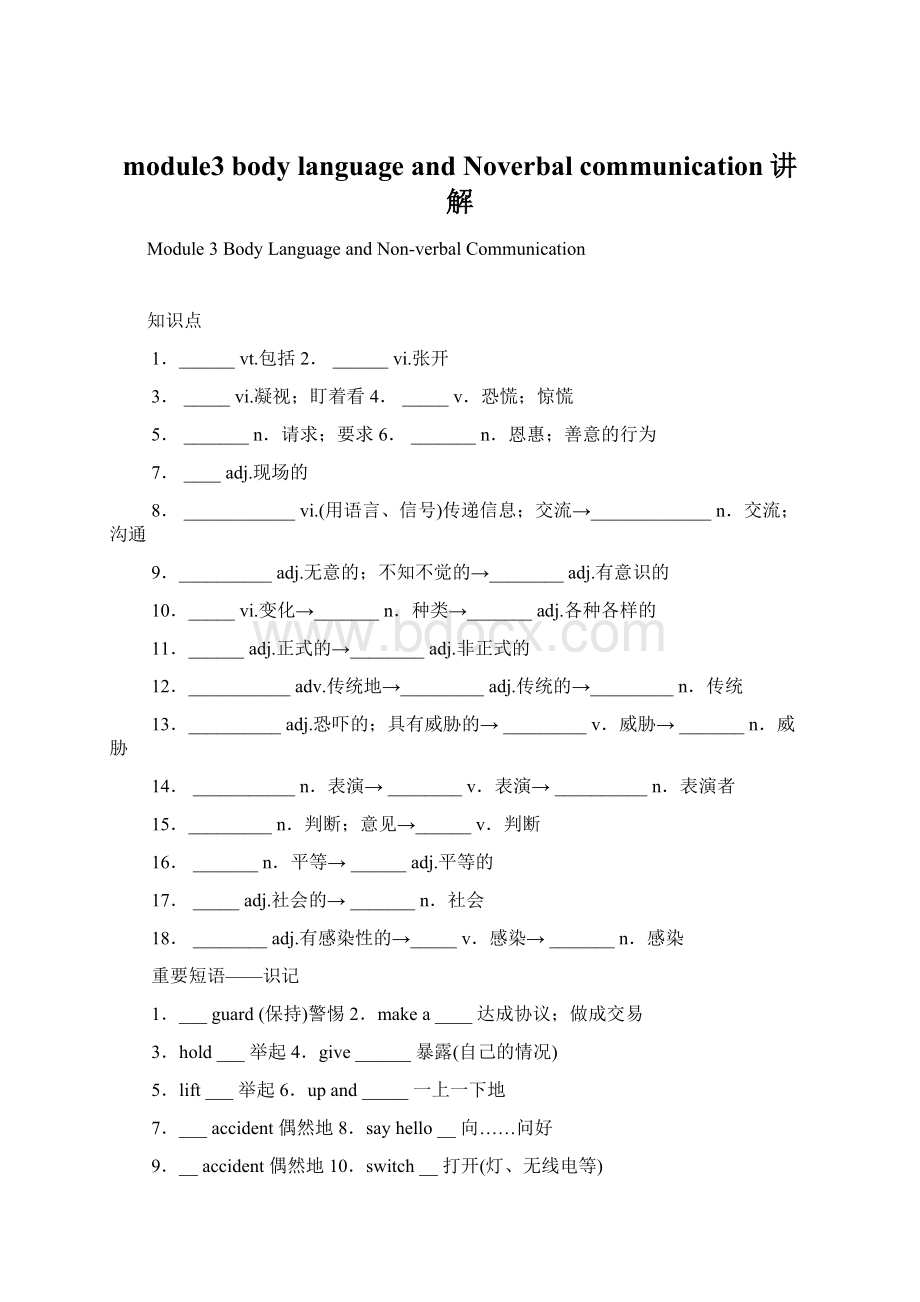module3 body language and Noverbal communication讲解.docx
《module3 body language and Noverbal communication讲解.docx》由会员分享,可在线阅读,更多相关《module3 body language and Noverbal communication讲解.docx(16页珍藏版)》请在冰豆网上搜索。

module3bodylanguageandNoverbalcommunication讲解
Module3BodyLanguageandNon-verbalCommunication
知识点
1.______vt.包括2.______vi.张开
3._____vi.凝视;盯着看4._____v.恐慌;惊慌
5._______n.请求;要求6._______n.恩惠;善意的行为
7.____adj.现场的
8.____________vi.(用语言、信号)传递信息;交流→_____________n.交流;沟通
9.__________adj.无意的;不知不觉的→________adj.有意识的
10._____vi.变化→_______n.种类→_______adj.各种各样的
11.______adj.正式的→________adj.非正式的
12.___________adv.传统地→_________adj.传统的→_________n.传统
13.__________adj.恐吓的;具有威胁的→_________v.威胁→_______n.威胁
14.___________n.表演→________v.表演→__________n.表演者
15._________n.判断;意见→______v.判断
16._______n.平等→______adj.平等的
17._____adj.社会的→_______n.社会
18.________adj.有感染性的→_____v.感染→_______n.感染
重要短语——识记
1.___guard(保持)警惕2.makea____达成协议;做成交易
3.hold___举起4.give______暴露(自己的情况)
5.lift___举起6.upand_____一上一下地
7.___accident偶然地8.sayhello__向……问好
9.__accident偶然地10.switch__打开(灯、无线电等)
A核心单词——巧布点,基石奠
1.varyvi.变化,不同vt.变更,改变
Thenatureandthedegreeofsuchcontactvaryagreatdeal.(2012·上海卷,阅读D)
交流的天性和程度变化很大。
(3)variousadj.各种各样的;多方面的variableadj.易变的;变化无常的
①Thecolorofthatanimal__________theseason.这种动物的颜色随着季节而改变。
②Thoughonthesamefamily,thebird_________sizeandcolor.虽属同科,这种鸟大小、颜色不一。
2.involvevt.包括;涉及;使参与
“Genius”isacomplicatedconcept,________manydifferentfactors.(2012·上海卷,39)
A.involvedB.involvingC.toinvolveD.beinginvolved
3.requestn.请求,要求v.请求,要求
He___________________presentatthemeetingontime.
他要求他们准时出席会议。
requestthat+从句请求……request后的宾语从句、表语从句、同位语从句以及Itisrequestedthat...从句中
用虚拟语气,即谓语动词用(should+)动词原形形式。
Irequestedthatheshouldcomeanhourearlier.我请求他早一个小时来。
4.favourn.恩惠;善意的行为;赞成;偏袒v.支持;偏袒
①Couldyou______________andturnoffthatlight?
劳您的驾,请把那盏灯关掉好吗?
②Everyonepresentis__________hisproposal.
在场的每一个人都赞成他的提议。
②favour the new plan赞成新计划
favour sb./sth.偏爱;偏袒某人;便于,利于.....
favour sb. with sth.为某人做某事/应某人要求做某事
误区警示:
Do me/us a favour!
在口语中往往是回答认为愚蠢的问题,意为“得了吧!
”
而do sb. a favour在疑问句表示“请求别人的帮忙”的客气表达。
朗文在线:
②Do us a favour, Mike, and shut up!
拜托你,迈克,别再说了!
③Are you in favour of the death penalty?
4.panic n.恐慌,惊慌v.陷入恐慌;引起恐慌(panicking,panicked,panicked) 归纳拓展
(1)get into a panic 陷入恐慌状态 be in (a) panic在惊慌中
be seized with a panic惊慌失措 cause a panic引起恐慌
(2)panic at...因(听到/看到„„)而惊慌 panic sb.into doing sth.使某人仓促行动
例句:
She got into a real panic when she thought she’d lost the tickets.
她十分惊慌,以为自己把入场券丢了。
Shoppers fled the street in (a) panic after two bombs exploded.
两枚炸弹爆炸之后,购物者惊慌失措地逃离了那条街。
5.spread (spread,spread)v.展开;铺开;传播;散开;伸展;延伸 n.传播;扩展 归纳拓展
spread sth.on/over sth.把某物铺在.....上
spread sth.with sth.把某物涂在......上
spread out展开;张开;扩大(张);伸长
例句:
She spread the pages of the letter on the table.她把那几页信展开放在桌上。
She spread the bread with butter. 她把黄油涂在面包上。
The fire spread from the factory to the houses nearby.
火从工厂蔓延到附近的房舍。
【链接训练】
Bird flu has ________ all over the world,which might panic the investors.
A.spread B.spreaded C.spreat D.spreading
6.stare vi.凝视;注视;盯着看 同类辨析
stare at由于好奇、敌视、傲慢而睁大眼睛凝视
glare at 怒视,瞪眼 glance at 匆匆一瞥
gaze at由于兴趣、喜欢或惊奇而目不转睛地凝视 look at看,看着
例句:
He stood there staring into the distance.他站在那里,凝视着远方。
He glanced at his watch.他匆匆地看了一下手表。
They stood glaring at each other.他们站着,彼此怒目而视。
【链接训练】
The old gentleman just stood there ______ at the pickpocket and did not say a word.
A.glancing B.glimpsing C.staring D.glaring
7.present
1)n.[C]礼物;目前
I want to give her a present. What do you think she'd like?
我想要给她一份礼物,你认为她会喜欢什么呢?
2)vt. 赠送;给予
The mayor presented the prizes in person. 市长亲自颁奖。
3)adj. 在场的;出席的(其反义词为absent);现在的;目前的;当前的
①A lot of students were present at the meeting. 很多学生出席了那个会议。
②I'm free at present. 我现在有空。
知识拓展
presence n. 在场;存在 presently adv. 不久 注意:
当present用于make someone a present of something(意为“把某物作为礼物送给某人”)这一结构时,不能与gift换用。
The________were tired of his long and tiring speech.
A.present people B.presently people C.people present D.people presently
8.serve vt. & vi.
1)vt. & vi. 为.....工作;为......服务
Can I serve you in any way?
我能帮你的忙吗?
2)vt. & vi. 开板;上菜(常用被动结构);供某人饭菜
①Dinner is served.开饭了。
②Learn to serve at table.学习端饭上菜。
3)vt. & vi. 任职;服役
He served as a naval officer during the war.战争时期他在海军当军官。
即学即用
The word“spahetti”brought back the memory of an evening when all of us were seated
around the table and Aunt Pat________spaghetti for supper.
A.cooked B.Served C.got D.made
B核心短语——点入线,基础建
1.giveaway暴露(自己的情况);泄露;分发或赠送某物;(由于大意)未利用或抓住(时机、机会等)
Ifapersonhasnothadenoughsleep,hisactionswillgivehimawayduringtheday.
givein屈服;让步_________散发;放出
_________分发;用完;耗尽;发出givewayto给……让路;被……代替
giveup放弃
①Thedoctorshadto________thedyingpatientafterefforts.
几经努力,医生只好停止给那个濒死的病人治疗。
②It'spoliteto_________inanarrowpassage.
在狭窄的过道里给人让路是很礼貌的。
2.makeadeal达成协议;做成交易
①Thebook________whatto______such_____.
本书论述了怎样处理这类交易的问题。
②Herpoemsoften_________thesubjectofdeath.
她的诗通常是关于死亡这一主题的。
deal n.交易,协议;v.处理,相处
(1)That’s a deal.一言为定。
(2)a great/good deal of+不可数名词,意思是“大量,很多”。
(3)deal with对付;应付;处理;对待 辨析:
do with与deal with
在表示“处理,对待”时,do with 和deal with 在陈述句中可以互相替换。
但是在特殊疑问句中,表示“怎么处理,怎么对待”时,用法不同。
⑦What do you do with the difficulties you face?
=How do you deal with the difficulties you face?
你是怎么处理你遇到的困难的?
—I know this is the latest type but it’s secondhand.$20—that’s my last offer.
—OK.It’s a(n) ________.
A.business B.Trade C.agreement D.dea
3.hold up举起;提出(作为榜样);延误,阻滞 归纳拓展
hold back阻挡,忍住,抑制 hold on坚持住;(电话用语)请稍等,不要挂断
hold out维持;抵抗 hold back缩回;阻止;隐瞒;抑制
hold in抑制(感情等) hold down阻止(某人),制止;限制
hold on to抓紧;不放开;保住(优势);不送(或不卖)某物
hold one’s breath屏住气
例句:
The steel strike in U.S. may hold up production of all new cars for several months.
美国钢铁工人罢工可能使全部新汽车的生产停顿好几个月。
They hold up his behaviour as a model.他们把他的行为作为其他人学习的楷模。
【链接训练】
There was a big hole in the road which________the traffic.
A.took up B.brought back C.kept back D.held up
【解析】句意为:
公路上有个大坑阻碍了交通。
hold up“延误,阻滞”,符合题意。
take up“占据,从事”;bring back“带回”;keep back“扣留,隐瞒”。
【答案】D What shall we use for power when all the oil in the world has been ________?
A. given out B. held up C. run out D. used up
4.lift up (被)提起;举起;抬高;吊起
I lifted the lid of the box up and peered in.
我掀起箱盖往里看。
知识拓展
not lift/raise a finger/hand(to do sth.) 一点忙也不帮;油瓶倒了都不扶 lift off 发射;起飞;升空
辨析:
raise, rise与lift up
1)raise是及物动词,“使„„上升”。
2)rise是不及物动词,“升起;上升;起立”。
①Prices have been raised up.价格被提高了。
②Prices rose gradually.价格逐渐地涨上去了。
3)lift up 举起;提起;使振奋;鼓舞 Lift it up to the table.把它抬到桌子上。
即学即用
(2009·北京东城模拟)
When I told him to make an apology, he________his eyebrows and said, “Apologize?
Why?
”
A.held up B.put up C.came up D.lifted up
5.take off 1)脱掉(衣服等)
2)突然急升;大受欢迎;极为成功
3)起飞 4)休假 5)突然离开
①Take your coat off and sit down.把外套脱掉坐下吧。
②I forgot to take off my makeup last night.昨天我忘了卸妆。
③Sales of home cars have taken off recent years.私家车的销售量近年来上升很快。
④I hear the business is really taking off.我听说生意真的要兴隆了。
⑤The plane took off despite the fog.尽管有雾飞机仍照常起飞。
链接:
take after(在礼貌、行为等方面)与(某个长辈)想像 take apart 拆卸;拆开
take away 减去 take back 收回
take in 收容(养);欺骗 take over 接管;接收 take up 从事;占据 高考直击
(2009·安徽)We tried to find a table for seven,but they were all________.
A.given away B.kept away C.taken up D.used up
To tell you the truth, you have________the chance of getting a good job this time.
A.thrown off B.taken off C.thrown away D.given in
C核心句型——线入面,灵犀现
1.Bodylanguageisfascinatingforanyonetostudy.身势语对任何研究者来说都是吸引人的。
Thismachineisveryeasy________.Anybodycanlearntouseitinafewminutes(2012·辽宁卷,29)
A.operatingB.tobeoperatingC.operatedD.tooperate
2.InFranceyoushouldshakehandseverytimeyousayhelloandgoodbye.
在法国,每次打招呼或告别时,你都要(与别人)握手。
此处everytime引导时间状语从句,表示“每当……的时候”。
类似结构常见的还有①the序数词time(第……次做……的时候)②last/nexttime(上次/下次做……的时候)③any/every/eachtime(任何一/每次做……的时候)④themoment/minute/second/instant(一……就)相当于连接词,引导时间状语从句。
(At)themoment(that)theboysawme,heranaway.那小男孩一见我就跑。
(For)thefirsttime(that)Imether,shewasalittlegirl.第一次我见她的时候,她还是个小女孩。
注意:
前面的介词和后面的that省则一起省;留则一起留。
每次看到这种事物我都恶心
Ifeelsick__________________suchfood.
工作难干,我都有点不知所措
Withwork__________,I‘msomethinglikeataloss.
啥时候想来就来
Justcometovisitme__________________.
经过努力我发现这个问题不像想象中那么难解决
Throughefforts,Ifindtheproblem____________________assupposed.
3.Perhaps more than I think.也许比我想的要多。
more than比.....多;多于 归纳拓展
(1)more than+名词(动名词),意思是“不仅仅是,不只是”。
more than+数词,意思是“超过,„„以上”。
more than+形容词,意思是“非常,很”。
(2)no more than仅仅,不过 not more than至多,不超过 more than a little非常
more than one...不止一个......more or less差不多;或多或少
(3)more...than这种结构是对于不同的人或物的同一性质或方面的比较,意为“比„„更(形容词和副词的比较级);与其说.......倒不如说.......”。
例句:
He is no more a genius than I am. 我不是天才,他也不是。
Mr Smith is more a writer than painter.
与其说史密斯先生是个画家,倒不如说他是个作家。
同类辨析
no more than与not more than
(1)no more than=only,含有消极否定的意思,意为“不过,只有,仅仅”。
(2) not more than=at most,意为“不超过,至多”。
例句:
He has learned no more than 100 words. 他才学会了100个单词。
He has learned not more than 100 words. 他学会的单词不超过100个。
(2)no more...than (not...any more than)跟从句,表示两者皆否定的观念,意思是“不„„正如„„不„„一样”。
例句:
A nation cannot exist without people any more than a tree can grow without roots.
一个国家不可能离开人民而存在,正如树没有根不能生长一样。
(3)not more...than跟从句,表示两者皆肯定的观念,只是有差别而已,意思是“不及„„那样”。
例句:
He is not more diligent than you are.他不像你那样勤奋。
【链接训练】
①—Do you need any help,Lucy?
—Yes.The job is______I could do myself.
A.less than B.more than C.no more than D.not more than
过去完成时
一、过去完成时的概念与结构特点
概念:
过去完成时表示在过去某一时间或动作之前已经发生或完成了的动作,即“过去的过去(past-in-the-past)”。
----|--------------------------|-------------------------------|---------------------------->
那时以前 那时 现在